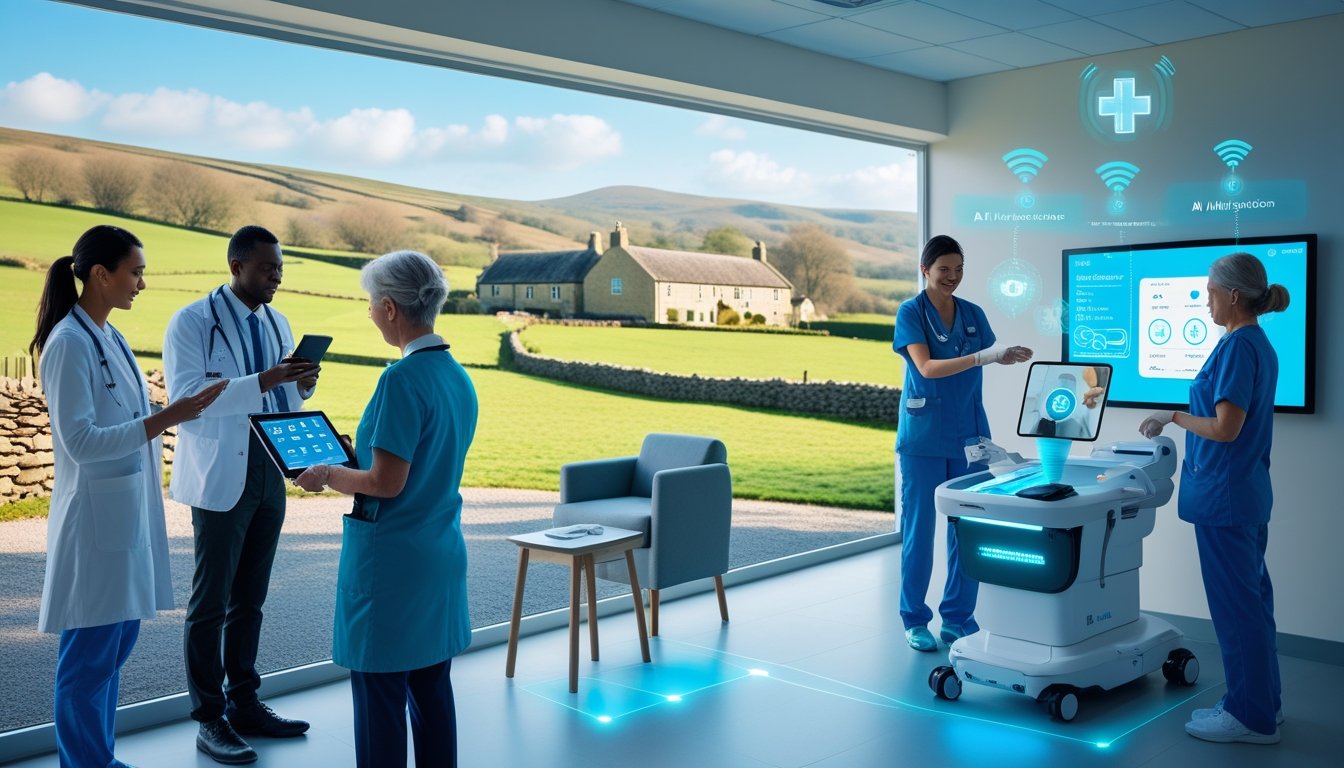Late updated: 27 Oct 2025 11:10
Written by: Oliver Bennett
AI-Powered Innovations For Rural UK Healthcare: Transforming Access And Quality
Artificial intelligence is revolutionising rural healthcare in the UK, addressing longstanding challenges through innovative technologies. By enhancing access and efficiency, AI empowers healthcare providers to deliver high-quality care even in isolated areas. AI-powered innovations are bridging the gap between rural and urban healthcare, ensuring that quality services are accessible no matter where one lives.

In rural communities, the scarcity of healthcare resources often leads to disparities in treatment and preventive care. AI offers promising solutions to these persistent issues, improving diagnostics, streamlining workflows, and supporting overburdened medical professionals. By integrating AI into existing infrastructure, we can create a more resilient rural healthcare system in the UK.
As we navigate the complexities of healthcare delivery in under-resourced areas, AI stands out as a transformative force. It holds the potential to not only improve patient outcomes but also optimise the use of limited resources. As such, it is imperative that we continue to explore how AI can drive meaningful advancements in rural healthcare.
Key Takeaways
- AI enhances healthcare efficiency and access in rural UK areas.
- AI-driven solutions improve diagnostic and patient outcomes.
- AI optimises resources in under-resourced rural communities.
Transformative AI Technologies Enhancing Rural Healthcare
Our focus here is on how AI technologies are revolutionising healthcare delivery in rural areas. These innovations are improving healthcare access and service quality by utilising machine learning, telemedicine, predictive analytics, and advanced diagnostic tools.
AI-Powered Telemedicine Platforms
AI-powered telemedicine platforms are dramatically altering healthcare delivery in rural regions. These platforms use machine learning to streamline healthcare access by facilitating virtual consultations. With limited healthcare providers, rural patients can connect with specialists remotely, bypassing the constraints of geographical proximity. These platforms offer video consultations, e-prescriptions, and even remote physical examinations through AI-assisted diagnostics tools.
Rural communities benefit from real-time interaction with healthcare professionals, reducing travel time and expenses. Telemedicine also supports chronic disease management by maintaining regular check-ins, ensuring that follow-ups are no longer missed. Our ability to integrate AI with telemedicine holds great potential for overcoming the hurdle of accessibility in rural healthcare services.
Predictive Analytics And Disease Prediction
Predictive analytics and disease prediction offer transformative potential in resource-limited rural settings. AI systems, through machine learning algorithms, analyse extensive datasets to forecast potential health issues. By predicting diseases like diabetes or hypertension, healthcare providers can implement preventive measures before the illness manifests.
The use of predictive analytics assists in tailoring personalised healthcare plans, helping to prioritise high-risk patients for earlier intervention. These capabilities allow for optimised resource allocation, ensuring efficient use of medical infrastructure. Our focus on data-driven insights can potentially predict illness trends, improving both individual patient outcomes and broader community health.
AI-Driven Diagnostics In Resource-Limited Settings
AI-driven diagnostics are particularly beneficial in rural areas where resources and trained professionals are scarce. Implementing AI technology assists in diagnosing conditions with a high degree of accuracy and speed. Such technologies include automated image analysis for radiology and pathology, which can support understaffed facilities.
AI-driven tools reduce diagnostic errors and augment the capabilities of existing healthcare providers. These systems enable providers to identify anomalies and patterns in medical images that might go unnoticed by humans. Our introduction of AI into rural diagnostics presents the opportunity for significant improvement in healthcare outcomes, making more accurate and timely interventions possible.
Remote Monitoring And Wearable Devices
Remote monitoring and wearable devices are redefining patient care in rural areas by harnessing the power of AI. Wearable devices equipped with sensors track vital signs, enabling continuous monitoring of patients with chronic conditions. These devices gather data in real time, alerting healthcare providers to any concerning changes.
AI systems analyse this data to generate insights, assisting in ongoing health management outside of traditional settings. Patients in rural areas gain autonomy and peace of mind, knowing their health is being monitored continuously. Our expanding use of these technologies aids in proactive healthcare, reducing the need for frequent travel to clinics and hospitals.
Improving Health Outcomes And Overcoming Challenges In Rural Communities

AI technologies can significantly boost healthcare quality and access in rural areas. By implementing specialist support and mobile health solutions, rural communities can receive timely care. Furthermore, addressing technological and systemic barriers is essential for successful AI adoption. Exploring future directions can guide us in creating a more equitable healthcare landscape.
Enhancing Healthcare Quality And Access
Integrating AI in rural healthcare can transform how services are delivered. By analysing large datasets, AI algorithms can predict health trends and optimise resource allocation, leading to improved patient care. Telemedicine bridges geographic barriers, providing virtual consultations for those unable to travel long distances. This technology broadens access and improves healthcare quality by ensuring consistent, accessible care.
Moreover, AI supports early diagnosis and preventive care, which are critical for reducing morbidity and mortality rates. For example, predictive analytics can identify communities at risk of specific health issues, enabling targeted interventions. These innovations ensure that rural residents receive the same quality of care as their urban counterparts, narrowing the healthcare disparity gap.
Specialist Support And Mobile Health Solutions
Availability of specialist care in rural areas is often limited. AI-powered platforms can facilitate connections between rural healthcare providers and specialists by providing virtual consultations and remote diagnostic capabilities. This collaboration ensures that patients receive the best care, despite their location.
Mobile health solutions, such as health monitoring apps and wearable devices, empower patients by providing them real-time feedback on their conditions. These technologies enable continuous monitoring and facilitate timely interventions. Our healthcare providers can leverage this data to deliver personalised care, improve patient outcomes, and manage chronic diseases more effectively. Access to specialist support and mobile health solutions ensures that rural populations receive comprehensive and tailored healthcare services.
Addressing Barriers To Adoption
Implementing AI in rural healthcare faces several barriers, including limited internet connectivity and a lack of digital literacy. Investing in infrastructure and education is crucial to overcoming these challenges. Training healthcare providers on new technologies improves their ability to use AI tools effectively, ensuring better patient management.
Privacy concerns and data security are also significant issues. Building robust cybersecurity measures and establishing clear data management policies are essential steps in ensuring trust and compliance. Garnering community support through stakeholder engagement can further ease adoption, helping communities embrace these innovations that are tailored to their needs.
Future Directions For AI In Rural Healthcare
Exploring the future of AI in rural healthcare, we must focus on developing user-friendly technologies that address specific community needs. Collaboration with local stakeholders ensures that solutions are pragmatic and sustainable. Governments and private sectors can play a role in funding research and providing incentives for innovation.
As we look ahead, continuous evaluation is key for measuring the impact of AI interventions on health outcomes. These insights guide us in refining applications and addressing areas needing improvement. By fostering partnerships and maintaining a forward-thinking approach, we can create a healthcare system where AI plays a pivotal role in promoting equality and improving lives in rural communities.
Frequently Asked Questions

In this section, we explore how artificial intelligence is transforming rural healthcare in the UK. The focus spans improving access to care, integrating into telemedicine, addressing professional shortages, and understanding cost impacts and ethical considerations.
How can artificial intelligence improve access to medical care in remote areas of the UK?
Artificial intelligence can overcome geographical barriers by enhancing telemedicine services. It helps healthcare providers offer timely diagnoses and treatment options remotely. AI tools assist in efficient scheduling and patient monitoring, making healthcare more accessible to those in isolated regions.
What are the challenges facing the deployment of AI-driven healthcare solutions in the rural UK?
Implementing AI in rural healthcare encounters several hurdles, including inadequate infrastructure and limited internet connectivity. There's also the challenge of ensuring that healthcare professionals are adequately trained to use these advanced technologies effectively.
In what ways has AI been effectively integrated into telemedicine services for rural communities?
AI augments telemedicine by offering predictive analytics and real-time data analysis. This integration allows for accurate monitoring of patient health and aids in the rapid decision-making process, enhancing the overall quality of care for rural communities.
What are the potential impacts of AI on reducing healthcare costs for rural populations?
By automating routine administrative tasks and optimising care delivery, AI can significantly reduce operational costs. Remote monitoring and diagnosis further help to cut down travel expenses for patients and reduce hospital visits, alleviating financial burdens on rural populations.
How does AI contribute to overcoming the shortage of medical professionals in rural UK regions?
AI assists by automating routine tasks, giving healthcare workers more time to focus on complex patient needs. It supports decision-making through data analytics, enabling practitioners to manage larger caseloads more efficiently.
What privacy and ethical considerations arise with the use of AI in managing patient data in rural healthcare settings?
Privacy concerns centre around the secure handling of sensitive patient information. Ensuring data protection is crucial, and ethical considerations arise regarding consent and the transparency of AI-driven decisions. Addressing these issues is vital for building trust in AI systems within rural healthcare communities.
